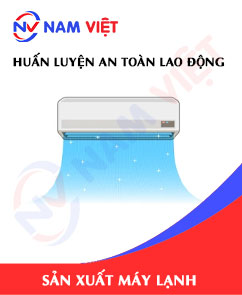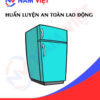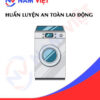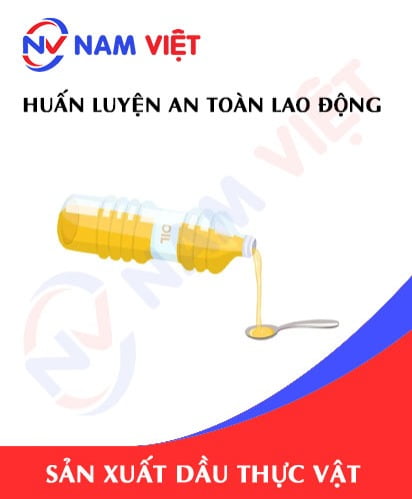Occupational Safety Training For Air Conditioner Manufacturing
99,000 ₫
Note: The above price is calculated for one person, the price may fluctuate depending on the number of trainees participating in the course and the movement of the market. For more accurate pricing support, please refer to the quotation or contact directly with our consultants.
Occupational safety is an important issue in air conditioner manufacturing factories and needs to be addressed promptly to ensure the health and safety of workers, as well as to enhance the reputation of enterprises. The Occupational Safety Training course is one of the effective solutions to raise awareness about preventing occupational accidents for workers participating in air conditioner manufacturing.
Table of Contents
Toggle1. Overview of Air Conditioners
a. What is an Air Conditioner?
An air conditioner, also called a climate control unit, is a device used to cool air and regulate temperature in living or working spaces. Air conditioners can be used in homes, offices, shops, restaurants, hotels, computer rooms, server rooms, and other locations.
Air conditioners utilize various technologies to cool the air, the most common being the heat exchange process between refrigerant and the air in the space, controlled by a temperature management system.

b. Types of Machinery Used in Air Conditioner Manufacturing
The machinery used in air conditioner production includes:
- Copper extrusion machines: used to manufacture copper pipes for the air conditioning system.
- Copper pipe cutting machines: used to cut copper pipes into required lengths.
- Copper pipe bending machines: used to bend copper pipes into various shapes for assembly into air conditioner components.
- Plastic extrusion machines: used to extrude and shape plastic parts of air conditioners.
- Copper pipe welding machines: used to weld copper pipes together.
- Air compressors: used to compress air and generate the airflow necessary for the air conditioner.
- Assembly machines: used to assemble air conditioner components into complete units.
- Quality inspection machines: used to check the quality of air conditioner products before they leave the factory.
These machines are typically used in air conditioner manufacturing plants for processing components, assembly, and quality control.

c. Air Conditioner Manufacturers in Vietnam
There are many well-known air conditioner brands worldwide, including:
- Daikin: A Japanese brand established in 1924, famous for inverter air conditioners and air purifiers.
- Mitsubishi Electric: From Japan, established in 1921, a leading brand for air conditioners, washing machines, televisions, and other electronics.
- Samsung: A South Korean conglomerate founded in 1938, renowned for air conditioners, televisions, mobile phones, and other electronics.
- LG: Also from South Korea, established in 1958, famous for air conditioners, televisions, washing machines, and other electronics.
- Carrier: A U.S. brand founded in 1915, a leading name in air conditioning solutions.
- Gree: A Chinese brand established in 1991, known for air conditioners, air purifiers, washing machines, and electronics.
- Panasonic: From Japan, founded in 1918, a leading brand in air conditioners, washing machines, televisions, and other electronics.
- Sharp: Japanese brand established in 1912, known for air conditioners, televisions, mobile phones, and electronics.

d. Specific Jobs in Air Conditioner Manufacturing Plants
Group 1
- Executive directors, deputy directors, and department heads in the air conditioner manufacturing plant.
Group 2
- Safety officers: manage safety in the factory, design safety procedures, supervise and ensure workers follow safe work processes.
Group 3
- Component production: Produce components such as copper pipes, fans, compressors, valves, controllers, and other required materials using specialized machinery.
- Assembly: After component production, workers assemble the components into the air conditioner frame. Parts are connected and positioned accurately before being fixed together.
- Quality inspection: After assembly, the air conditioner is tested to ensure it functions properly and meets safety and performance standards.
- Packing and transportation: After quality checks, air conditioners are packed and stored in the warehouse before being delivered to dealers or customers.
Group 4
- Office work, service, sales, and marketing.
- Production management, quality management, human resource management, material management, financial accounting management.
- Design: Designers create technical drawings, position and allocate components and materials required for air conditioner production.

2. Overview of Occupational Safety Training for Air Conditioner Manufacturing
In this article, we focus on issues related to Group 3 because Group 3 directly participates in the production process and faces the highest occupational safety risks. For information about other groups, see here.
a. What is Group 3 Occupational Safety Training?
- Group 3 occupational safety training consists of sessions that provide workers with knowledge on how to prevent occupational accidents.
- The training course helps workers identify and avoid hazards, minimizing the risk of workplace accidents.
REGISTER FOR OCCUPATIONAL SAFETY TRAINING SERVICE
b. Training Duration
Initial Occupational Safety Training Duration
- Total training time is at least 24 hours, including exam time.
- 8 hours of theory on policies, laws on occupational safety and hygiene
- 8 hours of theory on basic knowledge of occupational safety and hygiene
- 4 hours of theory on specialized training content
- 2 hours of practical training on specialized content
- 2 hours of final theoretical examination
The training center will divide the time into multiple sessions depending on workers’ schedules. Typically, there are six sessions over three days if the manufacturer can arrange continuous learning time.
Periodic Occupational Safety Training Duration
- Before the occupational safety card expires, workers must undergo periodic occupational safety training, with training time at least 50% of the initial training duration.
Explanation: Total periodic occupational safety training time is at least 12 hours, including exam time. After completing the periodic course and passing the test, the worker will have their occupational safety card reissued or extended.
c. Training Content
| No. | TRAINING CONTENT | TRAINING DURATION (HOURS) | |||
| Total | Including | ||||
| Theory | Practice | Exam | |||
| I | Policies and Laws on Occupational Safety and Hygiene | 8 | 8 | 0 | 0 |
| 1 | Overview of laws and legal documents on occupational safety and hygiene. | 6 | 6 | ||
| 2 | Standards and technical regulations for occupational safety and hygiene. | 1 | 1 | ||
| 3 | Specific regulations by state authorities on safety and hygiene when building, expanding, or renovating facilities for manufacturing, using, storing, and inspecting machines, equipment, materials, and substances with strict safety and hygiene requirements. | 1 | 1 | ||
| II | Basic Knowledge of Occupational Safety and Hygiene | 8 | 8 | 0 | 0 |
| 1 | Basic knowledge about hazards and harmful factors in the workplace. | 4 | 4 | ||
| 2 | Methods to improve working conditions. | 1 | 1 | ||
| 3 | Safety culture in production and business. | 1 | 1 | ||
| 4 | Rights and responsibilities of employers and employees; safety policies and regulations for employees; roles and responsibilities of safety officers. | 1 | 1 | ||
| 5 | Safety rules, signs, instructions, usage of safety equipment, personal protective equipment; first aid and occupational disease prevention skills. | 1 | 1 | ||
| III | Specialized Training Content | 6 | 4 | 2 | 0 |
| Comprehensive knowledge about machines, equipment, hazardous substances; risk analysis, assessment, and management of occupational safety; safe working procedures with machines, equipment, and substances with strict safety and hygiene requirements. | 6 | 4 | 2 | ||
| IV | Final Safety Training Examination | 2 | 2 | 0 | 0 |
| Total | 24 | 22 | 2 | ||
See more training content of the 6 groups
d. Occupational Safety Card
After completing the occupational safety training and passing the examination, workers will be issued an occupational safety card (commonly called a Group 3 occupational safety certificate).
The Group 3 card includes information such as name, date of birth, specific job and work environment. It also contains training duration, red seal, and signature confirming course completion.
According to regulations on card issuance stated in Clause 2 of Article 24 of Decree 44/2016/ND-CP, there are two cases:
- If the employer and employee have a labor contract, the employer must sign, stamp, and affix the card for the Group 3 trained employee after completing the training and passing the examination.
- If the worker is freelance or seasonal with no labor contract, the training unit must sign, stamp, and affix the card after the worker completes the training and passes the examination.

3. Identifying Hazards Affecting Workers During Air Conditioner Manufacturing
During the air conditioner manufacturing process, workers may face various hazards, including:
- Electrical hazards: Air conditioner manufacturing staff often work with high-voltage electricity, which can cause electrical accidents if protective equipment is not used properly.
- Machinery hazards: Workers must operate complex machinery, which can cause accidents if safety measures are not ensured.
- Material hazards: Materials used in air conditioner manufacturing, such as metals, chemicals, and liquefied gases, can be toxic and affect workers’ health.
- Noise hazards: Machinery in air conditioner factories produces high noise levels, which can harm hearing and overall health of workers.
- Pressure hazards: During manufacturing, workers handle liquefied gases and high-pressure equipment, which can cause accidents if safety is not maintained.
- Temperature hazards: Air conditioners are often manufactured in low-temperature conditions, which may reduce the body’s adaptability to the working environment and cause other health issues.
- Fire and explosion hazards: Flammable materials and liquefied gases in air conditioner manufacturing can cause fire or explosions, requiring workers to strictly follow safety procedures.
- Hazardous substances: Workers may be exposed to hazardous materials such as mercury, Freon, and other complex compounds during manufacturing.

4. Types of Occupational Accidents Commonly Occurring During Air Conditioner Manufacturing
Common occupational accidents in air conditioner manufacturing may include:
- Accidents involving machinery and equipment: When working with machinery and equipment in air conditioner manufacturing, workers may experience accidents such as hand entrapment, cuts, impacts, burns, or suffocation.
- Chemical accidents: Some stages of air conditioner manufacturing involve chemicals such as refrigerants, oils, and other substances. Without proper protective equipment, workers may inhale or have direct contact with toxic substances, posing health risks.
- Temperature-related accidents: Manufacturing may involve high-temperature metal materials, which can cause burns or loss of sensation upon contact.
- Transport and installation accidents: When transporting or installing air conditioners, workers may encounter scratches, falls, or burns.

5. Safety Measures for Participating in Air Conditioner Manufacturing
Safety measures for participating in air conditioner manufacturing may include:
- Ensuring safe manufacturing processes: Factories must design safe manufacturing procedures and ensure that staff are trained on them. Controlling toxic substances and enhancing electrical safety are also very important.
- Providing protective equipment: Staff must be fully equipped with protective gear including safety goggles, masks, gloves, safety shoes, protective clothing, and helmets. These items protect employees from toxic substances and sharp materials.
- Occupational safety training: Air conditioner manufacturing staff must be trained in safety procedures, proper use of protective equipment, and hazard recognition to prevent workplace accidents.
- Regular equipment inspection and maintenance: Machinery must be inspected and maintained regularly to ensure safe operation. Staff should also be trained to detect technical issues and report them immediately to management.
- Material and waste management: Factories must manage materials and waste to ensure a safe working environment and protect the surrounding environment.
- Ensuring electrical safety: Electrical safety is crucial in air conditioner manufacturing. Staff must be trained to use electrical equipment properly and avoid electrical accidents.
- Periodically conducting occupational environment monitoring in factories, collecting and analyzing harmful factors to workers, and adjusting to reduce hazards to prevent occupational diseases.
6. Benefits of Occupational Safety Training in Air Conditioner Manufacturing
An Toan Nam Viet provides businesses with the following benefits upon completing occupational safety training courses in accordance with Decree 44/2016/ND-CP on occupational health and safety:
- Workers can recognize potential hazards and take preventive measures to avoid workplace accidents.
- Businesses can establish risk prevention measures in manufacturing, operation, and maintenance processes.
- Reduce costs associated with workplace safety risks.
- Uninterrupted manufacturing increases labor productivity and product quality.
- Compliance with labor safety regulations avoids legal risks.
- Enhances reputation and professionalism, thereby elevating the business brand.
Nam Viet’s training courses are solutions to protect individuals from external hazards that could cause injuries or, in severe cases, death.
REGISTER FOR OCCUPATIONAL SAFETY TRAINING SERVICE
7. Customer Feedback After Completing Occupational Safety Training in Air Conditioner Manufacturing
An Toan Nam Viet has many years of experience accompanying businesses in Vietnam, particularly in southern provinces and industrial parks. This responsibility is extremely valuable, so our Occupational Safety Training is increasingly professional. The growth of An Toan Nam Viet is driven by positive feedback and suggestions from businesses. Below are responses from partners we have served.
See more customer interviews after using services of An Toan Nam Viet
8. Occupational Safety Training Capacity of An Toan Nam Viet
An Toan Nam Viet is a reputable and quality center for occupational safety training in Vietnam. Training sessions are continuously conducted at factories, production workshops, or construction sites across the country (all 63 provinces of Vietnam).
REGISTER FOR OCCUPATIONAL SAFETY TRAINING SERVICE
Occupational Safety Training License
- An Toan Nam Viet has been inspected and certified by the Department of Labor – War Invalids and Social Affairs and granted a certificate of eligibility for occupational safety and hygiene training. This further strengthens our capability in occupational safety training.

Training Materials and Lectures
- Before being used in Occupational Safety Training courses, training materials are reviewed to ensure accuracy and practical effectiveness.
- Instructors’ teaching methods are standardized according to An Toan Nam Viet guidelines, developed by experts in occupational safety and hygiene training to maximize knowledge retention for learners.
Facilities
- Controlling classroom factors that affect training improves teaching efficiency and learners’ knowledge absorption.
- Our training facilities feature spacious classrooms that meet standards for area, lighting, and training equipment, etc.
9. Nationwide Reputable Occupational Safety Training Center
At An Toan Nam Viet, professional dedication in occupational safety training is our top priority. Teaching workers how to protect themselves equips them with safety knowledge vital for their work and contributes to national development.
To ensure effective training, we meticulously prepare every detail: tools, equipment, teaching materials, documents, audio, and lighting.
Our instructors are experts with many years of experience. They have even conducted research to identify hazards across all industries and how to prevent them.
Lectures are practical, vivid, and easy to understand, helping workers learn comfortably while acquiring knowledge. The content strictly follows Decree 44/2016/ND-CP.
Thus, workers learn preventive measures and self-protection strategies and apply them appropriately in their daily work.
Our training center proudly provides reputable, professional occupational safety training with the following advantages:
- Competitive training costs without compromising quality.
- Flexible training schedules to match companies’ production plans.
- Fast, legally compliant certification procedures.
- Experienced instructors with many years in the field.
- Controlled classroom environment to improve teaching efficiency and knowledge retention.
- Lectures tailored to workplace safety needs in enterprises.
- An Toan Nam Viet works diligently and professionally to support clients accurately and promptly.

10. Additional References for Air Conditioner Manufacturing Occupational Safety Training
- Occupational Safety Training Materials
- Air Conditioner Manufacturing Safety Materials
- Occupational Safety Test Materials
- Air Conditioner Manufacturing Occupational Safety Training Curriculum
- Air Conditioner Manufacturing Occupational Safety Quiz
1 review for Occupational Safety Training For Air Conditioner Manufacturing
No comments yet















namchinh.haiphong341
Đơn vị an toàn lao động uy tín tại Việt Nam nhé!